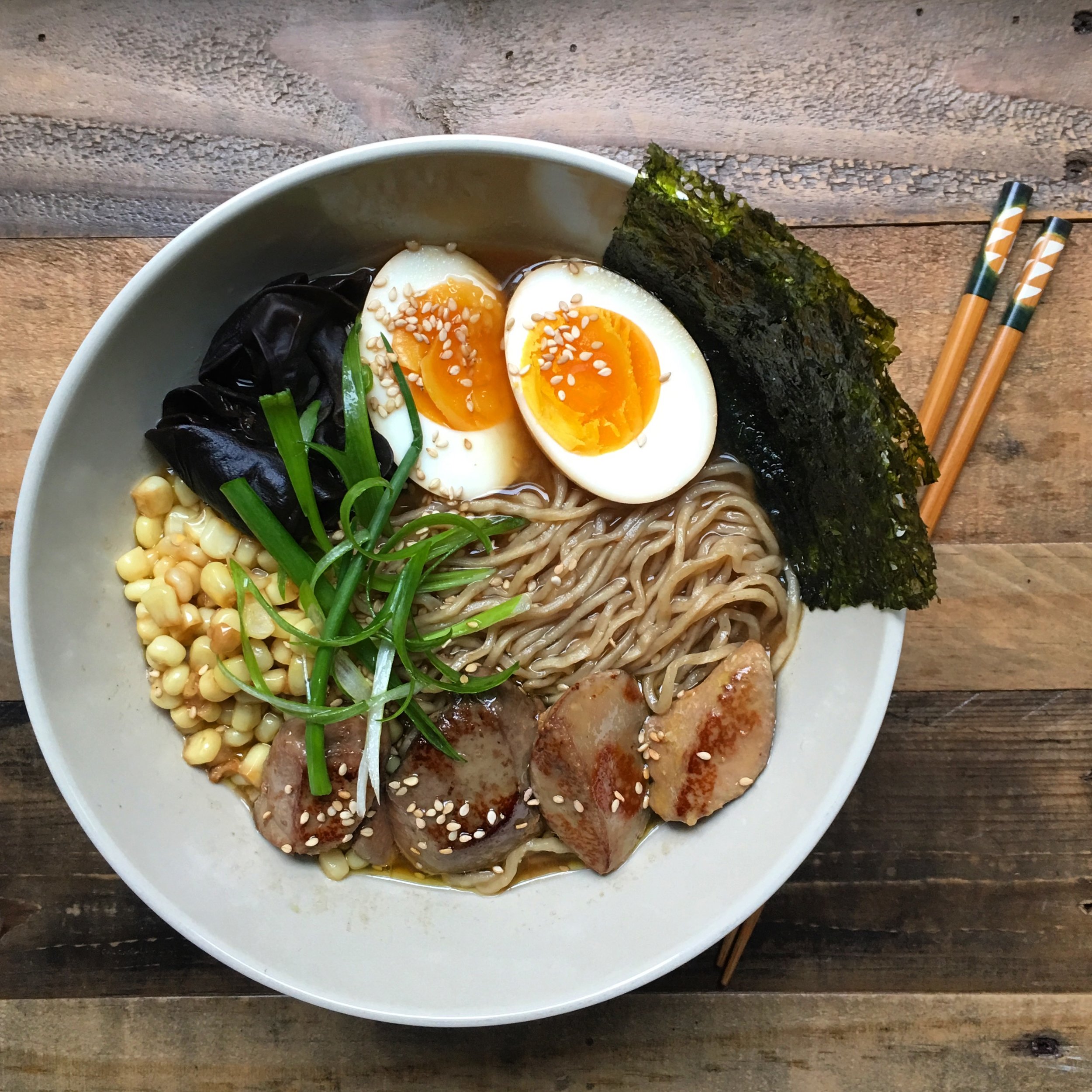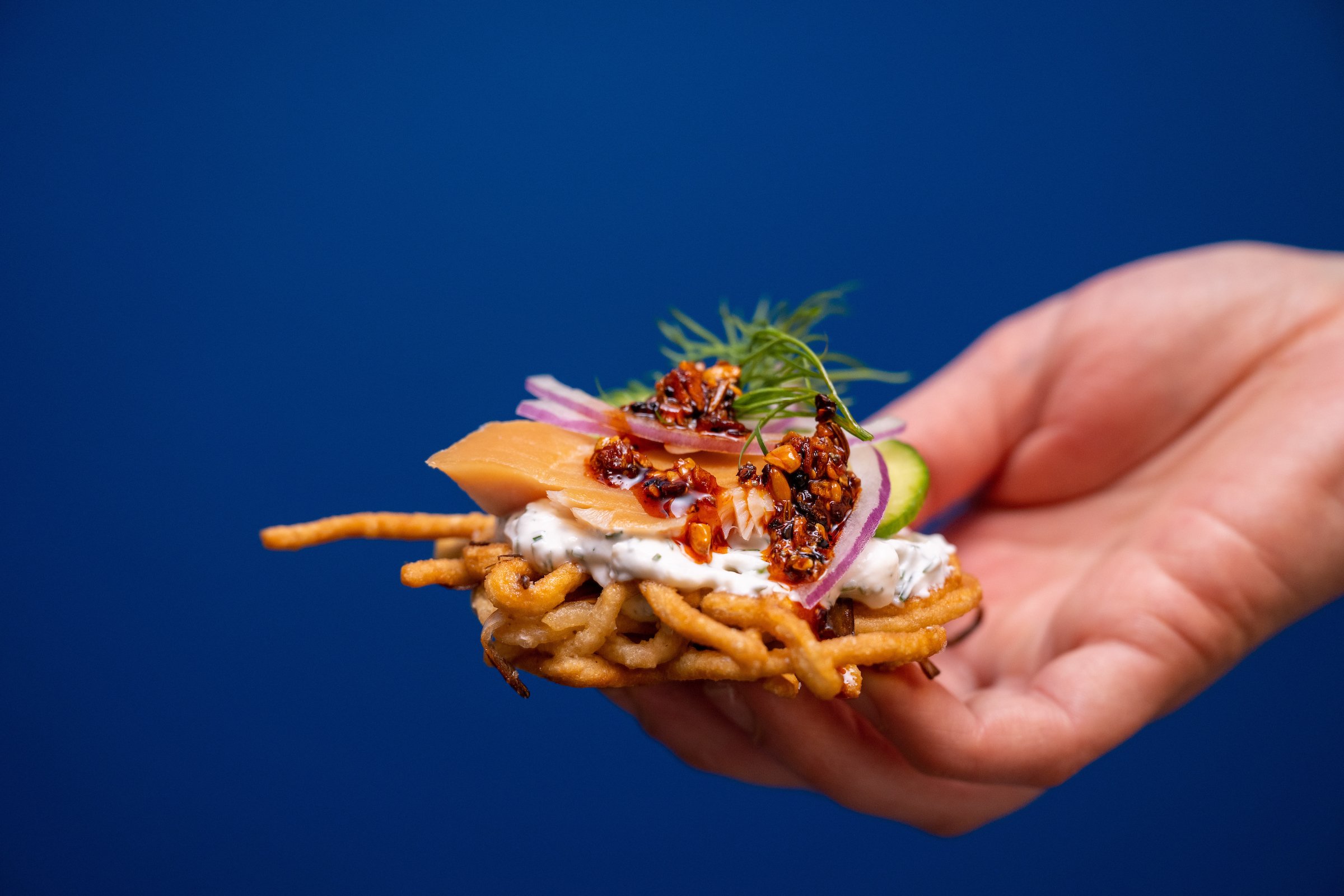The nice thing about miso ramen is that it’s rich enough for rainy days, but can be lightened up for spring by mixing up the veggies.
My tare (seasoning liquid) has kind of a crazy backstory, but it’s my secret ingredient in making about a million things taste better. I roast a whole pig every year over chipped branches from my apple and peach trees, then I throw the smoky skin and all the bones and weird face bits into a 23-quart stock pot and pressure cook it for three hours or so, then strain it all after the pot has cooled off. I pressure-can most of this stock in quart jars for later ramen broth (or cooking beans), but I save about a gallon of it and reduce it down by about 50 percent, until it’s thick and unctuous and a nice mahogany color. This is the base of my tare, and it can be frozen in small tubs or also pressure canned in half-pints. IF YOU AIN’T GROK THESE CHORES, it’s okay, I have a shortcut, described below. Go nuts!
Makes 3 servings
Miso-Dashi Broth:
4 cups water
4”x6” strip of kombu seaweed
Handful of shaved bonito
Optional: a few dried anchovies and a few dried shiitake
3 tablespoons of your favorite miso (I used red)
1 teaspoon freshly grated ginger
1 garlic clove, crushed and minced
Pork Tare (if you are not going whole hog, literally - see above):
4 pounds meaty smoked pork neck bones or smoked chicken thighs (available from Edelweiss or Gartner’s or Russian meat markets like Overseas Taste)
12 cups water
1 onion, halved (not peeled) or 1 large leek, chopped
2 large carrots, chopped
3 sticks celery, chopped
Optional: a few fresh parsley stalks, thyme sprigs and bay leaves
Ramen:
6 teaspoons soy sauce
3 teaspoons mirin
3 teaspoons sake
One 12-ounce pack Umi Organic ramen noodles
Suggested toppings:
Scallion threads: finely slice lengthwise and soak in a bowl of ice water until they curl (or finely sliced crosswise is fine too)
6-minute shoyu egg: Boil an egg for six minutes, peel, and soak in soy sauce with a little mirin and sugar added until they’re stained brown, at least 24 hours.
Miso-butter corn: melt a tablespoon of butter over medium heat, stir in a teaspoon of miso, then heat up frozen corn in the mixture until warmed through
Nori sheets
Woodear mushrooms, soaked in warm water until fully “bloomed”
Sliced bamboo shoots
Sliced roast pork or chicken
Beni shoga (pickled ginger in slivers)
Sesame seeds
Directions
Dashi:
Bring water to a boil with kombu seaweed, and a handful of shaved bonito. (I make it a little more intense by adding a few dried anchovies and a few dried shiitakes, but you can leave these out if you want.) Turn down the heat and simmer for about fifteen minutes, then strain. Or you could just use dashi powder and skip this step. Stir in the miso, whisking if needed to fully dissolve, add the garlic and ginger, and simmer for 15 minutes.
Quicker smoked pork tare:
Add bones, water, onion or leek, carrots, celery, and optional parsley, thyme and bay, tied in a cheese cloth, to a large soup pot. Bring the liquid to a boil, then simmer over low heat for 2 hours. Let the liquid cool for about an hour, then strain the stock, reserving the solids and transferring the liquid to another container. This will make enough to freeze for future ramen.
Ramen:
Bring a large pot of water to a rapid boil.
Add 6 tablespoons of the homemade smoky pork jelly or 4 cups of the quicker smoked pork tare to the miso-dashi broth and season with soy sauce, mirin and sake. Simmer for 15 minutes or so before adding to the bowls. (I also add a few pinches of msg, which, let’s be honest, makes everything taste better.)
Tease apart ramen noodles and add to boiling water. Stir and cook in boiling water for 2 minutes. Drain well. Portion into three bowls. Ladle the broth into the bowls, stir noodles in the broth to loosen then, then add your favorite toppings. Itadakimasu!













